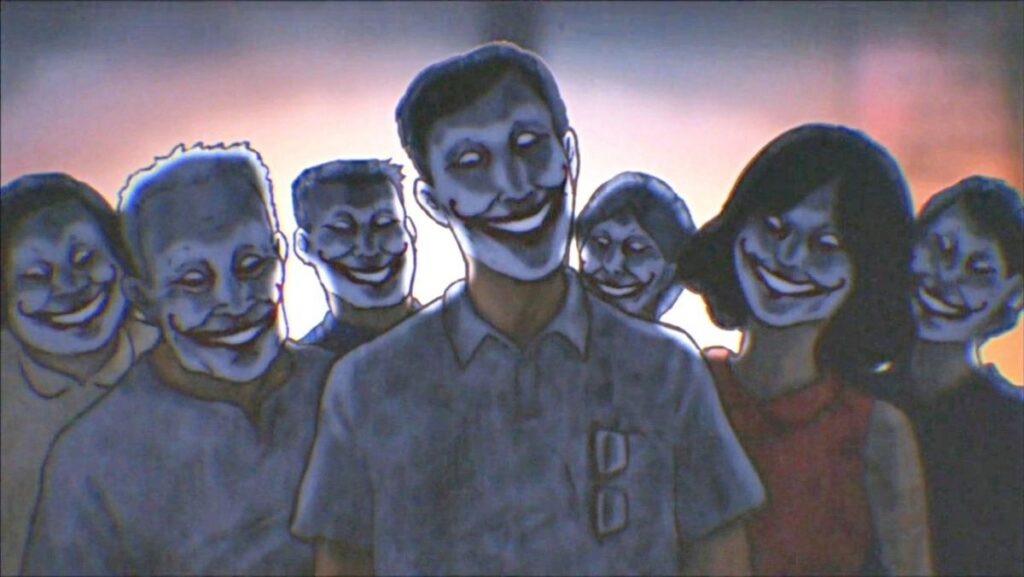Yamishibai, also known as Yamishibai: Japanese Ghost Stories and Theatre of Darkness: Yamishibai, is a series that few mention when discussing horror anime. However, it displays some of the most haunting images that keep viewers in a death grip of terror days after watching. There is a reason this series just completed its thirteenth season. Given its anthological style, not every story chills, but isn’t that the way with scary stories? Some make us laugh while others make us turn on all the lights in the house, light bill be dammed! Its unique animation, runtime, music, and relatable tales make it a knockout horror series that you should add to your Halloween viewing this year.
Yamishibai Uses Traditional Style Storytelling and Brings Terror to Anime
The series copies Kamishibai, a Japanese style of storytelling that uses picture cards for a paper play. Kamishibai was popular in the early twentieth century. So, the anime employs 2D cutout animation. But Yamishibai takes it further, making characters and backgrounds look like grainy, rough sketches. While the animation style may be initially disconcerting, there is a genius here. That grainy quality automatically adds a layer of discomfort, which increases as the story unfolds.
Each background and character oozes an underlying dread for what’s to come. From the first episode, “The Talisman Woman,” everything looks dim and oft-putting. Even though the characters’ mouths do not move, the expressions etched on their faces sell the horror, creating nightmare fuel for the viewer. Even within the 2D style, episodes have varying degrees of detail. Episodes like the eleventh season’s seventh episode, “That’s Not Right, Dad,” a story that takes bedtime tales to a horrifying and unexpected level, lean into more obscure backgrounds. It paints the landscapes in broader strokes while giving more details to the character, such as the hair.
Yamishibai Is Bite-Sized Terror
Thirteen seasons seem daunting to start. However, Yamishibai‘s episodes are very short. Seriously. You can watch the entire first season takes less than an hour. That also means it won’t take up much time. Each episode is four minutes long, including the intros and ending songs. So, skipping the intro and outro makes it even shorter. There is no gradual buildup of terror; it throws you in when all hell is about to break loose. Plus, it’s mostly in anthology format, which allows viewers to dive into the series at any point. But why spare yourself the frightful, pulse-pounding first season?
This Series Taps Into a Myriad of Emotions
Whether it’s emotions like love, jealousy, obsession, or loss, Yamishibai unravels the terrifying possibilities. It includes everyday activities in its horror, swiftly using the “what if” and hurling viewers off the emotional deep end. Episodes like the first season’s “Tomonari-kun” show the danger of making promises you do not plan to keep. Meanwhile, the third season’s “The Fourth Man” has an additional underlying fear in a world with new strains of illnesses running amok. The same goes for the latest season’s fourth episode, “Happy Girl Mushroom Tea,” which follows a girl looking to lose the weight she’s gained working remotely.
Some, like season five’s “Flower Reading,” a story of a man who meets a little girl whose fortunes are always right, or “Blackbean,” where a man’s recently deceased cat returns, use the paranormal to capture a tragic yet heartwarming tale of loss and reunion. To pack such an emotional gut punch in such a short episode speaks to the skillful way Yamishibai crafts its series. Its episodes resonate with our past, present, or fears and hopes for our future.
The Opening and Endings of Each Season Are Fantastic
Except for a few seasons, every season has the classic start of children playing in a part as the narrator calls for them to gather for storytime. They include the Kamishibai style, with a narrator and a small wooden stage for the intro. The sound effects are off-putting, with light wooden clanking. There is even what sounds like a shishi-odoshi, a bamboo fountain, which makes a distinct sound as the bamboo hits a rock. (Think of Kill Bill Part One when Beatrix fights O-Ren.)
The end songs differ for each season and are an eclectic mix of rap, rock, and pop with varying creepy tones. Often, the imagery accompanying these tracks remains clanging in the memory long after. With scratchy sound effects, eerie records on screen, and Hatsune Miku vocals, the first season’s “Kaikai Emaki” is disturbing, so much so that they use her vocals for the second season’s ending “Shinjukunichi Eyes.” But there are also the out-of-this-world heads rapping “Naa Naa Naa” as they increase with each episode of the third season before abruptly cutting off. It’s one of the terrifying best, on par with the creep from Paranoia Agent. Add to that the abrupt end of the rap, and Yamishibai brews an unforgettable mix of music and horror.
Yamishibai maintains a high level of surprises and terror, and—with its variety—it’s easy to find the episodes that chill you to the bone. What’s horrifying is how so many stories deal with people going about their everyday routines, shopping, working, going out to eat, and the terror finds them. With thirteen seasons under its belt, it’s time more people checked out what they’re missing. After watching this series, you’ll say, “Yamishibai no jikandayo,” and feel that chill travel up and down your spine.
Yamishibai is currently streaming on Crunchyroll.



